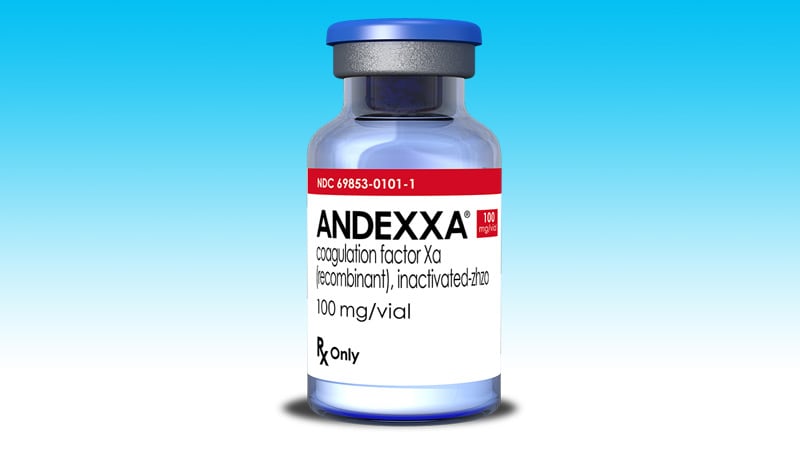The full results of the ANNEXA-I trial have continued to show mixed effects of the factor Xa inhibitor reversal agent, andexanet (Andexxa/Ondexxya, AstraZeneca), in patients with intracerebral hemorrhage who are taking factor Xa inhibitor anticoagulants, with uncertainly as to whether the benefits would outweigh the risks.
The trial results, showing better control of hematoma expansion with andexanet than usual care, but at the cost of an increased risk of thrombotic events including ischemic stroke, were first presented at last year’s World Stroke Congress (WSC).
The full results have now been published in The New England Journal of Medicine.
“Determining the potential net benefit of andexanet treatment in acute intracerebral hemorrhage is challenging because the relative clinical effects are difficult to assess,” the authors, led by Stuart Connolly, MD, McMaster University, Hamilton, Canada, concluded.
Investigators randomly assigned 530 patients who had taken factor Xa inhibitors within 15 hours of an acute intracerebral hemorrhage to receive andexanet or usual care.
The primary endpoint was hemostatic efficacy as defined by expansion of the hematoma volume by 35% or less at 12 hours after baseline, an increase in the score on the National Institutes of Health Stroke Scale of less than 7 points (scores range from 0 to 42, with higher scores indicating worse neurologic deficit) at 12 hours, and no receipt of rescue therapy between 3 and 12 hours.
This was achieved in 67.0% receiving andexanet and in 53.1% receiving usual care (adjusted difference, 13.4 percentage points; P=.003).
The between-group difference with respect to the primary endpoint was driven by differences in hematoma volume expansion, with little effect on the two other components.
A rapid reduction in anti–factor Xa activity was also observed with andexanet; a minimal reduction was observed with usual care.
However, there was an increase in thrombotic events and ischemic strokes in the andexanet group.
Thrombotic events occurred in 10.3% of those receiving andexanet vs 5.6% receiving usual care (difference, 4.6 percentage points; P=.048). Ischemic stroke occurred in 17 patients (6.5%) in the andexanet group and in four patients in the usual-care group (1.5%).
There were no appreciable differences between the groups in functional outcome as measured by modified Rankin scale score or in death within 30 days.
In an accompanying editorial, Wade Smith, MD, and Claude Hemphill, MD, University of California, San Francisco, pointed out that the timing and severity of ischemic strokes that occurred in the trial are not described, adding that it would be useful to know whether many of these patients had atrial fibrillation because they may be particularly vulnerable to transient hypercoagulability after receiving andexanet.
The editorialists noted that the biggest challenge in understanding how to apply the results of the ANNEXA-I trial comes from the choice of endpoints.
“The ability to limit hematoma expansion soon after intracerebral hemorrhage occurs is intuitively important, but ultimately what matters is whether patients have better long-term functional outcomes,” they wrote.
They noted that death and functional outcome at 30 days did not differ substantially between groups, and longer-term outcomes at 3 or more months, a standard measure in most stroke clinical trials, were not reported.
Smith and Hemphill referred to a previous trial of recombinant factor VIIa in noncoagulopathic intracerebral hemorrhage, which showed less hematoma expansion but no difference in clinical outcome, commenting that a single treatment approach may accomplish its physiological goal but may be insufficient to produce clinical benefit.
“We hope that this is not the case for factor Xa reversal in intracerebral hemorrhage,” they concluded.
The ANNEXA-I trail was supported by Alexion AstraZeneca Rare Disease, AstraZeneca Biopharmaceuticals, and, previously, Portola and Alexion Pharmaceuticals. Dr Connolly reports grants and consultancy fees from AstraZeneca.
>>> Read full article>>>
Copyright for syndicated content belongs to the linked Source : Medscape – https://www.medscape.com/viewarticle/mixed-results-factor-xa-reversal-agent-intracerebral-2024a10009am
